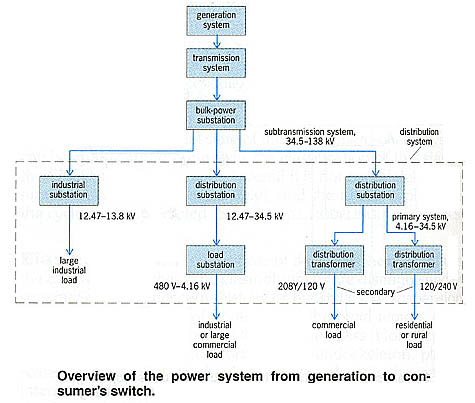AMAZON multi-meters discounts AMAZON oscilloscope discounts
An assembly of equipment in an electric power system through which electrical energy is passed for transmission, distribution, interconnection, transformation, conversion, or switching.
Specifically, substations are used for some or all of the following purposes: connection of generators, transmission or distribution lines, and loads to each other; transformation of power from one voltage level to another; interconnection of alternate sources of power; switching for alternate connections and isolation of failed or overloaded lines and equipment; controlling system voltage and power flow; reactive power compensation; suppression of over-voltage; and detection of faults, monitoring, recording of information, power measurements, and remote communications. Minor distribution or transmission equipment installation is not referred to as a substation.

Substations are referred to by the main duty they perform. Broadly speaking, they are classified as: transmission substations, which are associated with high voltage levels; and distribution substations, associated with low voltage levels.
Substations are also referred to in a variety of other ways:
1. Transformer substations are substations whose equipment includes transformers.
2. Switching substations are substations whose equipment is mainly for various connections and interconnections, and does not include transformers.
3. Customer substations are usually distribution substations on the premises of a larger customer, such as a shopping center, large office or commercial building, or industrial plant.
4. Converter stations are complex substations required for high-voltage direct-current (HVDC) transmission or interconnection of two ac systems which, for a variety of reasons, cannot be connected by an ac connection. The main function of converter stations is the conversion of power from ac to dc and vice versa. The main equipment includes converter valves usually located inside a large hall, transformers, filters, reactors, and capacitors.
5. Most substations are installed as air-insulated substations, implying that the bus-bars and equipment terminations are generally open to the air, and utilize insulation properties of ambient air for insulation to ground. Modern substations in urban areas are esthetically designed with low profiles and often within walls, or even indoors.
6. Metal-clad substations are also air-insulated, but for low voltage levels; they are housed in metal cabinets and may be indoors or outdoors.
7. Acquiring a substation site in an urban area is very difficult because land is either unavailable or very expensive. Therefore, there has been a trend toward increasing use of gas-insulated substations, which occupy only 5 - 20% of the space occupied by the air-insulated substations. In gas-insulated substations, all live equipment and bus-bars are housed in grounded metal enclosures, which are seated and filled with sulfur hexafluoride (SF gas, which has excellent insulation properties.
8. For emergency replacement or maintenance of substation transformers, mobile substations are used by some utilities.
An appropriate switching arrangement for “connections” of generators, transformers, lines, and other major equipment is basic to any substation design. There are seven switching arrangements commonly used: single bus; double bus, single breaker; double bus, double breaker; main and transfer bus; ring bus; breaker-and-a-half; and breaker-and-a-third. Each breaker is usually accompanied by two disconnect switches, one on each side, for maintenance purposes. Selecting the switching arrangement involves considerations of cost, reliability, maintenance, and flexibility for expansion.
A substation includes a variety of equipment. The principal items are transformers, circuit breakers, disconnect switches, bus-bars, shunt reactors, shunt capacitors, current and potential transformers, and control and protection equipment.
Good substation grounding is very important for effective re laying and insulation of equipment; but the safety of the personnel is the governing criterion in the design of substation grounding. It usually consists of a bare wire grid, laid in the ground; all equipment grounding points, tanks, support structures, fences, shielding wires and poles, and so forth, are securely connected to it. The grounding resistance is reduced enough that a fault from high voltage to ground does not create such high potential gradients on the ground, and from the structures to ground, to present a safety hazard. Good overhead shielding is also essential for outdoor substations, so as to virtually eliminate the possibility of lightning directly striking the equipment. Shielding is provided by overhead ground wires stretched across the sub station or tall grounded poles.